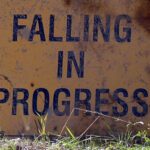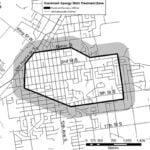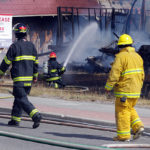Home »

Four lost Rovers from Cranbrook
By Elinor Florence
A group of young men from Cranbrook, members of the Rover branch of the Boy Scouts Association, built cabins deep in the forest to use as their private clubhouse in the happy days before the Second World War. Four of them died while serving their country. Now all that remains is the stone fireplace, a crumbling memorial to those brave young men who never returned to the mountains they loved so much.
Who Were the Rovers?
The Rover program was created by The Boy Scouts Association to provide an option for young men who had grown past the age limit of 17 years.
The Third Rover branch in tiny Cranbrook, in the mountainous southeast corner of the province – then with a population of about 3,000 people – was launched in the 1930s.
Led by Murray MacFarlane, the core group consisted of 16 young men: Lloyd “Butch” Burgess, Ted “Rasp” Smith, Frank Morro, Tack Wood and his brother Ed Wood, Fred Kolisnek, Frank Hinton, Jim Stone, Joe Ward, Frank Jones, Jim “Moose” Haley, Stan Whittaker, Ed Walsh and his brother Jerry, Stewart Flett, and Len Dingley.
The Rovers participated in scouting events, but what they really enjoyed was fellowship. That usually meant hiking, camping, hunting, or jumping on their CCM Redbird bicycles and pedalling into the mountains.
They documented many of their trips in elaborate journals, complete with maps, photos, and written accounts. Copies of those journals are now owned by the Cranbrook Historical Archives, and shared with me by local historian David Humphrey.
Building The Rover Cabin
When the Rovers decided to build themselves an outdoor retreat, it was a humble affair. It began as a small log cabin located about five kilometres southeast of town, in a beautiful clearing located on the banks of a rushing creek.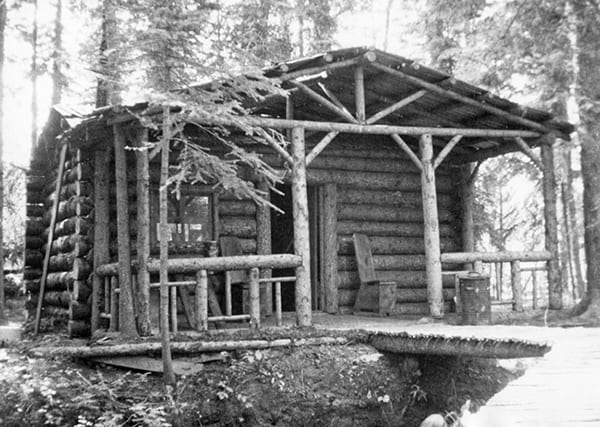
Lloyd “Butch” Burgess was a talented artist who sketched the cabin and many of the other illustrations in the Rover record books.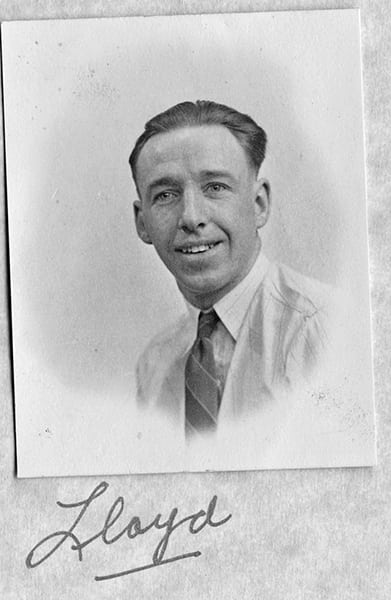
Here’s his sketch of the original, small Rover Cabin.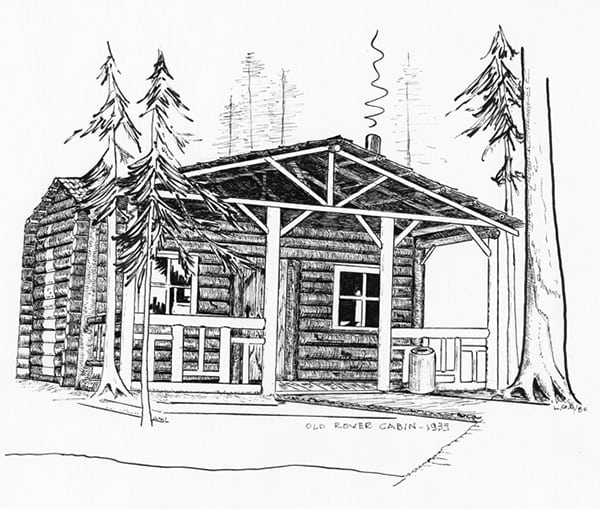
The Rover Cabin, or “The Den” or “The Shack” as it was called, was so well-used and well-loved that the boys built a large addition in 1935, by cutting and hauling the logs themselves.
Lloyd sketched the larger cabin while construction as still in progress, as you can see by the unfinished logs on the side. Notice the tree growing through the roof of the front deck!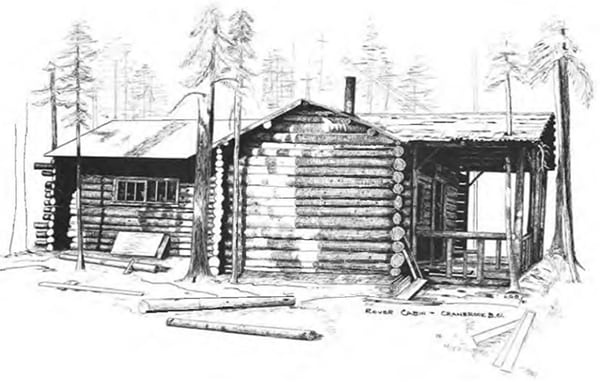
It took about an hour to hike or bike out from town, and everything in the cabin had to be carried on their backs or dragged on toboggans. To save effort, they dug a nearby root cellar where they could store their perishables.
The boys even built a bridge across the creek.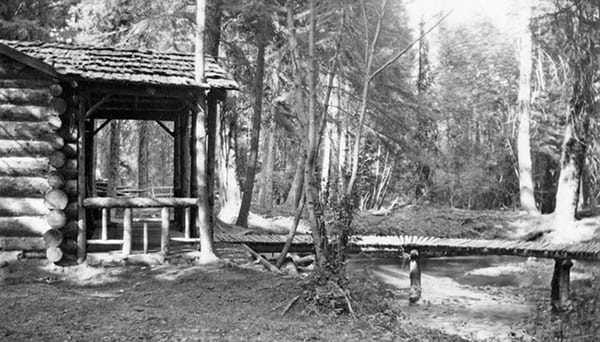
The stone chimney in particular was an impressive piece of work. How did they manage such a feat of engineering? As former Rover Tack Wood told local journalist Dan Mills in later years: “If we didn’t know exactly how to do something, we just used common sense and figured it out as we went. We all just pitched in and got it done.”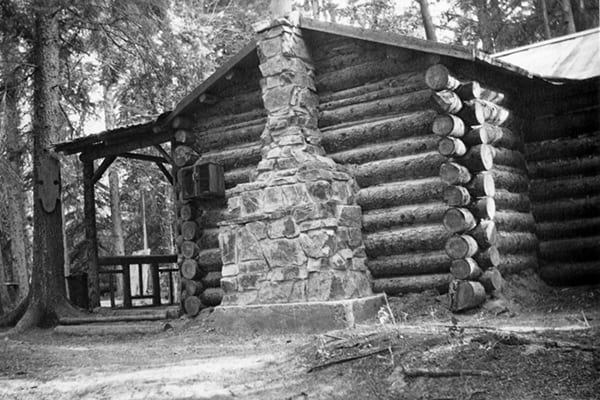
When completed, the fireplace served as a source of light and heat that proved especially useful in winter, since the cabin was used all year around.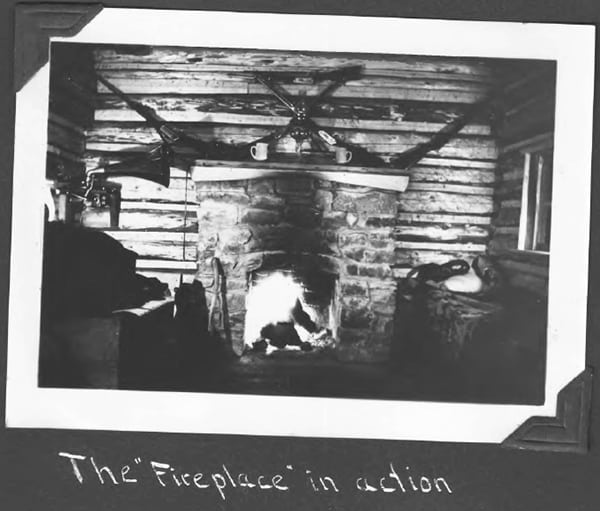
Happily, Frank Morro and Tack Wood also kept photo albums with many wonderful photos of the Rovers at work and at play. Here’s a great photo of seven Rovers, from left: Tack Wood, Ted Smith, Lloyd Burgess, Ed Wood, Ed Walsh, Jerry Walsh, and Frank Morro.
Rovers Enjoyed Fun and Fellowship
For about 10 years, the same group of young men enjoyed days, nights and weekends at the cabin. But it wasn’t until May 17, 1936 that they started a Rover Logbook to record all the activities that took place in the cabin, lasting until the final entry in June 1942.
Looking at the albums and reading the Rover Logbook, I was struck by the healthy, clean living that these young men endorsed. Drinking was never mentioned, poker games broke up because some of the players had to get up early and go to church in town; and young ladies were always mentioned with respect. Parents and friends were often invited to the cabin for meals, but even when the Rovers were alone, one of them always said grace.
However, boys being boys, they did a lot of wrestling, which often turned into fistfights. As Tack Wood explained: “Sometimes we used to play pretty rough. We made the furniture that was in the shack, and we broke most of it, too. There was never any hard feelings in the morning, though!”
For example, an entry on August 8, 1936 says that the boys started playing a card game at 10 p.m. and ended at 4:10 a.m. A few hours later, the boys “woke about 9 a.m. and fought until about 9:30 (during the fight, a lamp chimney was broken) and then sat down to breakfast. After breakfast, we spent the day playing tin-ball, duck on the rocks, and pig in the hole.” After a full day of activities, they went home about 8:45 p.m.
Here’s a photo of the boys playing cards.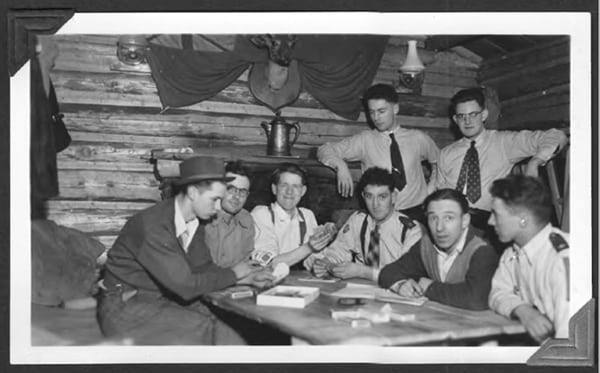
They also cut their own firewood, and kept the cabin clean and tidy. Frequent references were made to cutting the cards to see who washed the dishes. Eating was of utmost importance and meals were described in great detail.
On January 31, 1937, the card game “was broken up by short fights or scraps. Then the cards were put away and the feast began. Roast pork, mashed potatoes, parsnips, turnips, and crabapple jelly was topped off with huge wedges of pumpkin and apple pie.”
After supper, “an open discussion was held on forest fires, and the relative merits of Ford and Chevrolet trucks.”
Aside from eating and wrestling, there was little else in the form of indoor entertainment, so games were the order of the day. As well as whist and poker, they played Monopoly and pick-up sticks.
The boys also hauled a gramophone out to the cabin and spent many happy hours playing records. However, this was also a source of conflict, according to this entry on March 7, 1937.
“We sat up around the fireplace and played records until 4:50 a.m. Stone couldn’t sleep, so he took the music box and heaved it outside. We locked him out in his undies. He climbed in the window and got a sock on the head.”
This photo of Lloyd Burgess with the gramophone shows that it must have been pretty difficult to heave it out of the window. And apparently it still worked afterward, too.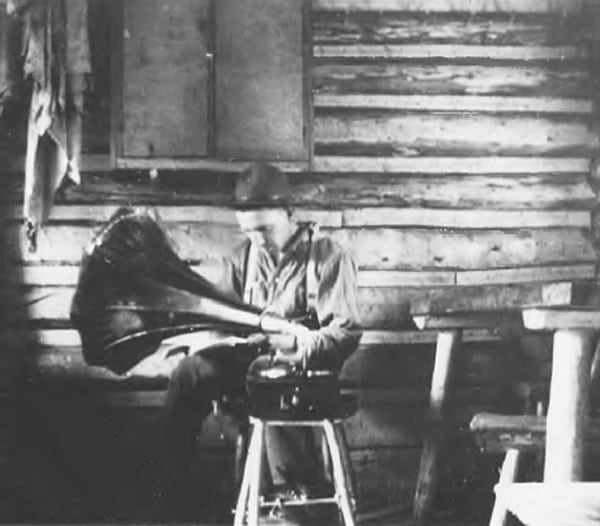
Outdoors, the boys came up with their own games: horseshoes, hiking, shooting gophers, target practice using tin cans, and marathon snowball fights that lasted for hours. One entry dated February 1937 reads: “Frank and Jerry played Cowboys and Indians on snowshoes.”
Here’s a game of target shooting in progress.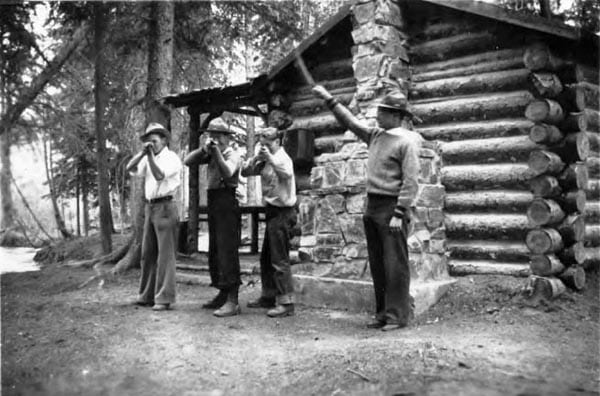
Mostly, the Rovers were all about exploring the natural world around them. They did a lot of hiking and camping trips. As they termed it, they “went Rovering” all over the surrounding mountains, keeping a record of all their expeditions. This photo shows them sitting on a mountaintop overlooking Cliff Lake.
Winter didn’t keep the boys at home. They cross-country skied for many miles (note the woolen clothing and the wooden skis) no matter what the weather.
They often had visitors from town at the Rover Cabin, including Boy Scouts, parents, and “lady friends.” An entry signed by Eileen Johnstone on November 30, 1938 reads: “The girls examined the cabin and surroundings and exclaimed with admiration and wonder!”
Here’s a photo of the boys entertaining the girls, sitting on the roof of the cabin.
War is Declared
When war began in 1939, there is no mention of it in the logbook, although its dark shadow fell into every corner of this country. Perhaps they preferred to keep this dreadful event separate from their happy days at the Rover Cabin.
But the war came to them anyway. After the British Commonwealth Air Training Plan brought thousands of young men to Western Canada from other countries to train here, many of them were welcomed into local homes.
One flyer made it to the Rover Cabin on Boxing Day 1941. An entry by Leading Aircraftman J. A. Street reads: “Today I spent the best day since leaving England and I wish the 3rd Cranbrook Rovers ‘Happy Hunting in 1942.’”
The English flyer was training at the Service Flight Training School in Calgary, and coincidentally was also a member of the Boy Scouts from Bristol, England.
However, this entry in the logbook dated April 26, 1941 proved prophetic.
“Came up to the shack to give L. Burgess a send-off party. Had small feed. Argued about war as usual. Burgess was given a present by local association. Question was brought up about where each Rover would be one year from today . . . if anywhere. Left shack at 12:45, still arguing war.” Signed: Frank Munro.
The Rovers were exactly what the armed forces wanted and needed. They were in fighting form, accustomed to hard physical labour, and best of all, they had already demonstrated unquestioning loyalty and dedication to their community and their country.
And so the Rovers left, one by one, eager to join the fight for freedom.
Haley, James Franklin
 Just over one year after the above diary entry was written, the first Rover died in combat.
Just over one year after the above diary entry was written, the first Rover died in combat.
Royal Canadian Air Force Flight Sergeant, Wireless Operator James Franklin Haley, was one of the first to enlist. He was already a seasoned veteran of RAF Squadron 150 when his bomber was shot down on June 16, 1942.
A short note accompanies this pre-war sketch in the Rover album belonging to Lloyd Burgess. “Nicknamed Moose, James Haley wore a perpetual smile. James loved being outdoors and spending time alone. He liked to hike around the hills and do a little prospecting. His goal was to be a Mining Engineer.”
It was not to be. James Haley was reported missing, and later declared dead. The son of James and Florence Haley (his widowed mother remarried before the war, and became Florence Pantling), his body was found and buried at Bergen-Op-Zoom War Cemetery, Noord-Brabant, Netherlands.
The following year saw another three Rovers meet their deaths.
Morro, Frank Peter
Royal Canadian Air Force Flight Sergeant, Air Bomber Frank Peter Morro, who wrote the entry about war at the Rover Cabin, was listed as missing on December 4, 1943 and later declared dead on April 12, 1943.
Frank was a member of RCAF Squadron 429, serving as an Air Bomber. The notes on his examination results read: “Air and ground work of exceptionally high standard. Intelligent and hard-working – excellent air crew type.”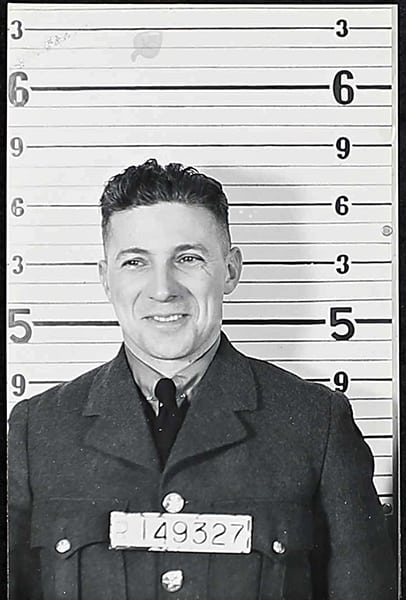
From the sketchbook of Lloyd Burgess: “He may be quiet and small, but he makes every part of his wiry frame count. If only a few more of the boys could work like he can. Doesn’t smoke or drink, has lots of patience, and always cheerful. A real friend.”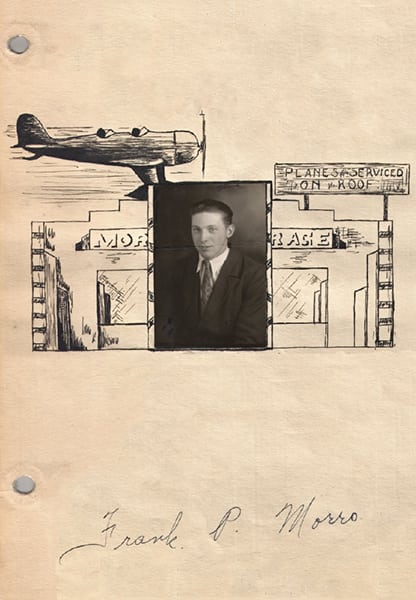
Frank was serving on a Halifax, on a bombing mission to Leipzig, Germany, when the seven-man bomber was shot down by a German fighter. Three of the aircrew baled out and were captured, but the other four men including Frank were killed in the crash.
The son of John and Eva Morro, Frank’s body is buried at Sage War Cemetery, Niedersachsen, Germany, beside those of his other three crew members who died in the crash.
Flett, Stewart MacKenzie
Just two months later, on June 11, 1943, Royal Canadian Air Force Flying Officer, Navigator Stewart MacKenzie Flett, was killed at the age of 27.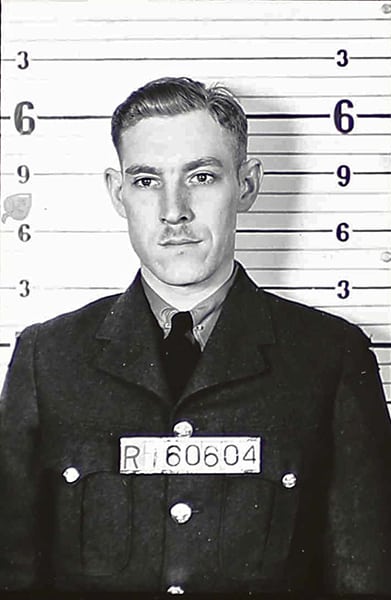
Notes on his RCAF training record read: “Is older than the average student and was a good, steadying influence upon the flight. Has a fine personality, neat in appearance. He is very alert, dependable, and cooperative. He is a good leader.”
From Lloyd’s pre-war sketchbook: “Tall and skinny, Stewart was called the life of the Rover parties. He was stubborn, not easily led, and would make a good politician. He loved to talk about science subjects and his goal was to be a Chemical Engineer.”
Stewart’s aircraft took off on November 6, 1943 on a training run, and for unknown reasons, most likely mechanical failure, it crashed near Jurby on the Isle of Man, just west of mainland England. Death was instantaneous for all crew members.
Stewart was the son of Thomas Robertson Flett and Annie Flett. His body is buried at Jurby (St. Patrick) Churchyard, Isle of Man, United Kingdom.
Dingley, Leonard Douglas
The fourth Rover who died was Royal Canadian Air Force Flying Officer and Navigator Leonard Douglas Dingley, who disappeared on flying operations on November 12, 1943 at the age of 24.
His RCAF training notes read: “Navigation ability exceptional – accurate and sure of himself. Works hard, and is very keen and interested.”
The son of Edgar George and Hilda Dingley, his body was never found. Instead, Len Dingley is commemorated at Runnymede Memorial, Surrey, England along with 20,285 other names.
The world would never be the same again – not only for the families of these brave young Rovers, but for the small community of Cranbrook and hundreds of others like it across Canada, which sacrificed so much in the name of freedom.
In 1947, the federal government established a program to honour Canadian servicemen killed in action during World War Two by officially naming geographic features in their memory. In the Cranbrook area, four mountains are named after the young Rovers who died: Mount Morro, Mount Haley, Flett Peak, and Mount Dingley.
Long after the war ended, the B.C. Forest Service discovered the abandoned Rover Cabin in the woods, and burned it down. It is their mandate to keep Crown land free of human habitation, and to prevent the cabin from being used for drinking or squatting.
 All that remains now is the stone fireplace.
All that remains now is the stone fireplace.
Every Remembrance Day for the last decade, Dan Mills of Cranbrook and several friends visit the remnants of the cabin, where they lay poppies to remember the four lost Rovers.
Here is a note from the Rover Logbook:
“We leave this book behind, so that others will know of the grand times, friendships, and the splendid trailing we have enjoyed in each other’s company. When we have drifted down life’s stream, we hope we shall be remembered for what we were, as well as for what will be.”
Somewhere among the beautiful forest and streams of the Canadian Rockies, the ghosts of the young Rovers can still be heard laughing in the natural world they loved so much.
We shall remember them.
All images provided courtesy of the Cranbrook Historical Archives

– Bestselling author Elinor Florence of Invermere has written a wartime novel titled Bird’s Eye View, telling the story of an idealistic Saskatchewan farm girl who joins the Royal Canadian Air Force.
My Favourite Veterans is a non-fiction collection of interviews whose stories appeared previously on e-KNOW, including Bud Abbott of Cranbrook and Jim Ashworth of Invermere.
Elinor’s new novel Wildwood, about pioneer life in the Peace River, Alberta region, was published in February 2018. All three books are available at Lotus Books in Cranbrook and at Lambert-Kipp Pharmacy in Invermere.
For more information about Elinor and her books, visit www.elinorflorence.com or call her at 250-342-1621.

